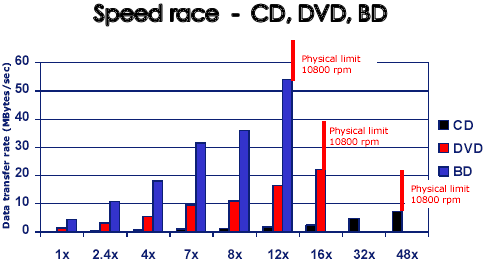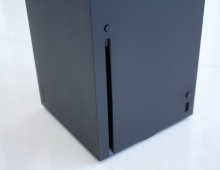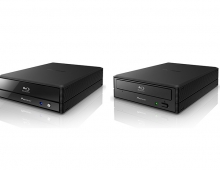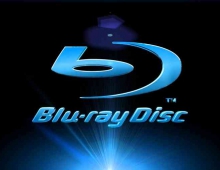
Recording on next-generation Blu-Ray Discs
Although the recordable/rewritable Blu-Ray disc is far from becoming a mainstream PC medium, hardware manufacturers already promote their PC drives that will support recording at speeds higher than 2x.
According to various announcements of the members of the Blu-Ray camp, Blu-Ray (BD) discs will be available in pre-recorded (BD-ROM), recordable (BD-R) and rewritable (BD-RE) versions. The companies plan to simultaneously launch all three versions in order to offer a more complete solution to the market. The Blu-Ray specifications also include both single-layer (SL) and dual-layer (DL) versions for the -ROM and -R versions, while a four-layer BD disc is not currently an option (although it might be an option later on).
Speaking about 12cm discs, a typical disc will hold approximately 25GB (SL), or 50GB (DL). The Blu-Ray specifications indicate that the Blu-Ray drive will feature 36Mbps transfer rate, meaning that 1X (CLV) BD writing takes place at this rate. Note that 36Mbps is equivalent of 3.26X in DVD terms. Philips/BenQ, Pioneer and HP have announced, however, that their first BD recorders will be launched at 2X speed. At 2X, a full disc recording can take place in 46.5 min (SL) and 93 min (DL).
Pushing the recording speeds further is not an easy task and requires developments in both hardware and materials. Disc physical parameters are also a limiting factor for the maximum attainable writing speed, including a high noise level during recording as well as vibration. But the most important factor is the maximum allowed spinning speed of an optical disc. For 12cm discs (CD/DVD), spinning an optical disc at 10,800rpm has been proven as the realistic upper bound for half-height drives. A 12cm BD disc rotates between 1955 and 821rpm (inner to outer diameter) at 1X speed, so simple calculations result to the fact that the 12X (CAV) is expected to be the upper limit (ceiling) for BD devices on a PC. This is a simple theoretical approach and of course, reaching the 12x CAV writing speed will also depend on the developments on the chemicals used for the disc (polycarbonate) and the performance/accuracy of the moving parts (hardware) used in a BD recorder.
Below is illustrated a graphical comparison of CD, DVD and BD discs, in terms of transfer rates at various recording speeds.

So as long as both blank discs and component designs can keep up, a full BD-R (SL) disc may be eventually written in approximately 11minutes. in case of rewritables and multilayered discs. In practice, the upper limit might prove to be as low as 6x, due to their complicated structure.
Latest information from the Philips R&D laboratories indicate that the 7x (4-7x CAV) recording speed on BD-R media has already been achieved. The BD-R media used for the experiments was not featuring a phase-change or a dye layer, but instead a Cu/Si bilayer was applied. With this technology, Philips scientists were able to achieve adequate recording quality (jitter below 6.5%).
Speaking about 12cm discs, a typical disc will hold approximately 25GB (SL), or 50GB (DL). The Blu-Ray specifications indicate that the Blu-Ray drive will feature 36Mbps transfer rate, meaning that 1X (CLV) BD writing takes place at this rate. Note that 36Mbps is equivalent of 3.26X in DVD terms. Philips/BenQ, Pioneer and HP have announced, however, that their first BD recorders will be launched at 2X speed. At 2X, a full disc recording can take place in 46.5 min (SL) and 93 min (DL).
Pushing the recording speeds further is not an easy task and requires developments in both hardware and materials. Disc physical parameters are also a limiting factor for the maximum attainable writing speed, including a high noise level during recording as well as vibration. But the most important factor is the maximum allowed spinning speed of an optical disc. For 12cm discs (CD/DVD), spinning an optical disc at 10,800rpm has been proven as the realistic upper bound for half-height drives. A 12cm BD disc rotates between 1955 and 821rpm (inner to outer diameter) at 1X speed, so simple calculations result to the fact that the 12X (CAV) is expected to be the upper limit (ceiling) for BD devices on a PC. This is a simple theoretical approach and of course, reaching the 12x CAV writing speed will also depend on the developments on the chemicals used for the disc (polycarbonate) and the performance/accuracy of the moving parts (hardware) used in a BD recorder.
Below is illustrated a graphical comparison of CD, DVD and BD discs, in terms of transfer rates at various recording speeds.

So as long as both blank discs and component designs can keep up, a full BD-R (SL) disc may be eventually written in approximately 11minutes. in case of rewritables and multilayered discs. In practice, the upper limit might prove to be as low as 6x, due to their complicated structure.
Latest information from the Philips R&D laboratories indicate that the 7x (4-7x CAV) recording speed on BD-R media has already been achieved. The BD-R media used for the experiments was not featuring a phase-change or a dye layer, but instead a Cu/Si bilayer was applied. With this technology, Philips scientists were able to achieve adequate recording quality (jitter below 6.5%).




















